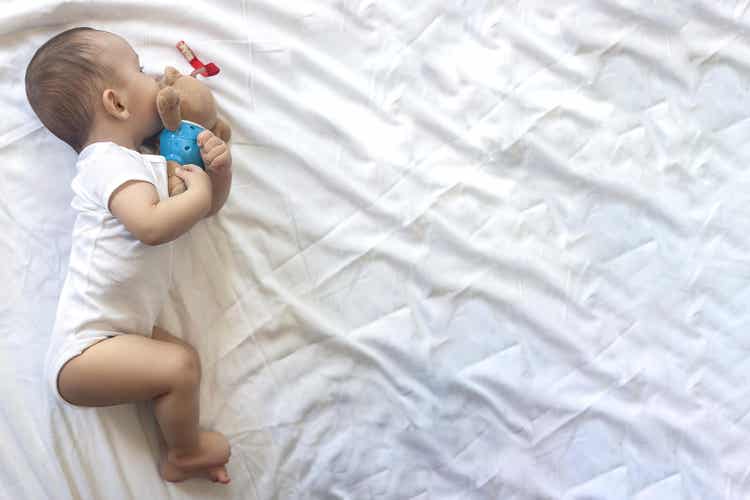6 Mistakes We Make Putting a Child to Bed


Written and verified by the psychologist Mara Amor López
At some point, without a doubt, you’ve had a hard time getting your child to sleep without complaining or waking up. Often, parents make the situation worse without even realizing it. In this article, we’re going to look at some mistakes we make when putting a child to bed and how we can solve them.
This way, you can find out if, without realizing it, you’ve been interfering with your child’s sleep. All you need to do is analyze these mistakes and try to correct them so that putting your child to bed is easy and efficient.
Mistakes we make when putting a child to bed
On many occasions, parents accidentally make bedtime harder than it needs to be. Of course, we make these mistakes without realizing it and with the best of intentions. However, it’s worth learning what these mistakes are in order to to find a solution and keep bedtime from being such a battle.
Not having a nightly routine
Most adults have our routines at the end of the day that helps us relax: Shower, dinner, reading a book, and sleeping, for example. In the same way, a young child needs a routine to be able to relax. If they don’t have one, it’ll be hard for them to calm down, which will end up affecting their sleep.

The solution is to create a routine at the end of the day. It doesn’t matter how old they are; a predictable routine will help them relax from the day and feel more confident.
- A routine for babies: Give them a bath, put on their pajamas, rock them a little, feed them (bottle or breastfeeding), and then put them in the crib to sleep. If they’re over 2 years old, you can leave them with a stuffed animal to comfort them when they wake up at night. However, make sure that there isn’t anything in the bed that could cause your child to choke or suffocate.
- A routine for older children: Give them a bath (or have them take a bath on their own), give them dinner, read a story, sing a song or pray, and go to sleep.
Too many stimuli in the crib
Another mistake we make when putting a child to bed is having too many stimuli in their crib or bed. If you turn on a colored lamp, a mobile with music, and all the other gadgets you can think of, you may think that you’re helping them sleep. However, all of these stimuli actually distract your little one and keep them awake.
The solution is to reduce the noise and make the room dark. Your child may need the help of a nightlight, but you should try and make it dim and not distract the little one.
If there’s a lot of noise outside, you can play white noise to reduce external sounds. White noise, being constant and monotonous, manages to help babies sleep without actually distracting them.
For older children, you should put away screens, cell phones, tablets, the TV, computers… All these stimuli activate the brain more at night. The brain interprets this light as daylight, making it harder for you to sleep.
Taking them out of the crib when they start crying
When your baby cries or complains at night, you might feel like you need to pick them up or feed them. But this might just be part of their sleep and they don’t actually need your intervention. If you pick them up, you’re actually taking away their opportunity to relax on their own and go back to sleep. If they cry persistently and still won’t calm down after a while, then you can go comfort them.
The solution is to wait a little while before going in so that you can see how they do on their own. Like adults, babies and children also wake up a little bit during the night.
When the baby starts to cry or whine, let them try to fall asleep alone for a few minutes. They aren’t born knowing how to calm themself down, so you have to give them the opportunity to learn.
Putting them to bed with a bottle
Some parents try to use a bottle to help their child relax and fall asleep, but this has risks:
- First, you’ll create dependency on a bottle, so that later, they won’t be able to fall asleep without it.
- Also, it’ll make it hard to remove the bottle and get them to drink from a cup.
- Finally, their risk of tooth decay increases.
The solution is that you should give them a bottle at mealtime, not bedtime. With the routine you create, your baby will learn to calm themself down, without needing a bottle. Otherwise, this habit could be hard to break later.
More mistakes when putting a child to bed

Letting them go to bed too late
Many parents work, come home late, and put their children to bed later so they can play with them for a while. However, the problem is that, if the child goes to sleep too late, they’ll be very tired, upset, and won’t want to fall asleep.
The solution is to set fixed bedtimes and respect them. Make a set time to start the routine and stick to it. If you make it a point to put them to bed when they start to scratch their eyes and yawn, it’ll be easier for them to learn to sleep alone.
Putting them to bed in different places
Sometimes we let our children sleep in bed with us if they’re sick. The problem is that we’re sending mixed signals to our little ones. If sometimes they have to sleep in their bed and other times they get to sleep in ours, we’re confusing them.
It’s best to explain where to sleep. If you don’t want your little one to come into your bed at night, you need to set rules. You need to explain that they need to sleep in their bed every night, throughout the night, because that way, everyone sleeps better.
If your child comes into your bed in the middle of the night, don’t scream at them or scold them. Without speaking, take them back to their bed, give them a good night kiss, and go back to your own bed.
Conclusion
Here, we’ve looked at some of the most common mistakes we make when putting a child to bed. Surely you do these things with the best of intentions, but you’re actually accidentally hurting your child’s sleep. With these tips, you can figure out what you’re doing wrong to try and correct it.
In the end, everything has a solution. If something isn’t going well, you have the possibility to change it. So, get down to work and analyze what you do well and what you need to work on.
At some point, without a doubt, you’ve had a hard time getting your child to sleep without complaining or waking up. Often, parents make the situation worse without even realizing it. In this article, we’re going to look at some mistakes we make when putting a child to bed and how we can solve them.
This way, you can find out if, without realizing it, you’ve been interfering with your child’s sleep. All you need to do is analyze these mistakes and try to correct them so that putting your child to bed is easy and efficient.
Mistakes we make when putting a child to bed
On many occasions, parents accidentally make bedtime harder than it needs to be. Of course, we make these mistakes without realizing it and with the best of intentions. However, it’s worth learning what these mistakes are in order to to find a solution and keep bedtime from being such a battle.
Not having a nightly routine
Most adults have our routines at the end of the day that helps us relax: Shower, dinner, reading a book, and sleeping, for example. In the same way, a young child needs a routine to be able to relax. If they don’t have one, it’ll be hard for them to calm down, which will end up affecting their sleep.

The solution is to create a routine at the end of the day. It doesn’t matter how old they are; a predictable routine will help them relax from the day and feel more confident.
- A routine for babies: Give them a bath, put on their pajamas, rock them a little, feed them (bottle or breastfeeding), and then put them in the crib to sleep. If they’re over 2 years old, you can leave them with a stuffed animal to comfort them when they wake up at night. However, make sure that there isn’t anything in the bed that could cause your child to choke or suffocate.
- A routine for older children: Give them a bath (or have them take a bath on their own), give them dinner, read a story, sing a song or pray, and go to sleep.
Too many stimuli in the crib
Another mistake we make when putting a child to bed is having too many stimuli in their crib or bed. If you turn on a colored lamp, a mobile with music, and all the other gadgets you can think of, you may think that you’re helping them sleep. However, all of these stimuli actually distract your little one and keep them awake.
The solution is to reduce the noise and make the room dark. Your child may need the help of a nightlight, but you should try and make it dim and not distract the little one.
If there’s a lot of noise outside, you can play white noise to reduce external sounds. White noise, being constant and monotonous, manages to help babies sleep without actually distracting them.
For older children, you should put away screens, cell phones, tablets, the TV, computers… All these stimuli activate the brain more at night. The brain interprets this light as daylight, making it harder for you to sleep.
Taking them out of the crib when they start crying
When your baby cries or complains at night, you might feel like you need to pick them up or feed them. But this might just be part of their sleep and they don’t actually need your intervention. If you pick them up, you’re actually taking away their opportunity to relax on their own and go back to sleep. If they cry persistently and still won’t calm down after a while, then you can go comfort them.
The solution is to wait a little while before going in so that you can see how they do on their own. Like adults, babies and children also wake up a little bit during the night.
When the baby starts to cry or whine, let them try to fall asleep alone for a few minutes. They aren’t born knowing how to calm themself down, so you have to give them the opportunity to learn.
Putting them to bed with a bottle
Some parents try to use a bottle to help their child relax and fall asleep, but this has risks:
- First, you’ll create dependency on a bottle, so that later, they won’t be able to fall asleep without it.
- Also, it’ll make it hard to remove the bottle and get them to drink from a cup.
- Finally, their risk of tooth decay increases.
The solution is that you should give them a bottle at mealtime, not bedtime. With the routine you create, your baby will learn to calm themself down, without needing a bottle. Otherwise, this habit could be hard to break later.
More mistakes when putting a child to bed

Letting them go to bed too late
Many parents work, come home late, and put their children to bed later so they can play with them for a while. However, the problem is that, if the child goes to sleep too late, they’ll be very tired, upset, and won’t want to fall asleep.
The solution is to set fixed bedtimes and respect them. Make a set time to start the routine and stick to it. If you make it a point to put them to bed when they start to scratch their eyes and yawn, it’ll be easier for them to learn to sleep alone.
Putting them to bed in different places
Sometimes we let our children sleep in bed with us if they’re sick. The problem is that we’re sending mixed signals to our little ones. If sometimes they have to sleep in their bed and other times they get to sleep in ours, we’re confusing them.
It’s best to explain where to sleep. If you don’t want your little one to come into your bed at night, you need to set rules. You need to explain that they need to sleep in their bed every night, throughout the night, because that way, everyone sleeps better.
If your child comes into your bed in the middle of the night, don’t scream at them or scold them. Without speaking, take them back to their bed, give them a good night kiss, and go back to your own bed.
Conclusion
Here, we’ve looked at some of the most common mistakes we make when putting a child to bed. Surely you do these things with the best of intentions, but you’re actually accidentally hurting your child’s sleep. With these tips, you can figure out what you’re doing wrong to try and correct it.
In the end, everything has a solution. If something isn’t going well, you have the possibility to change it. So, get down to work and analyze what you do well and what you need to work on.
All cited sources were thoroughly reviewed by our team to ensure their quality, reliability, currency, and validity. The bibliography of this article was considered reliable and of academic or scientific accuracy.
- Challamel, M. J., & Franco, P. (2011). Insomnio y trastornos de la instauración del ritmo día/noche en los niños pequeños. EMC-Tratado de Medicina, 15(4), 1-6.
- Estivill, E., & Segarra, F. (2000). Insomnio infantil por hábitos incorrectos. Rev Neurol, 30(2), 188-91. https://www.researchgate.net/profile/Eduard_Estivill/publication/267421412_EL_INSOMNIO_INFANTIL_POR_HABITOS_INCORRECTOS/links/54d79bc60cf25013d03ad547.pdf
This text is provided for informational purposes only and does not replace consultation with a professional. If in doubt, consult your specialist.








